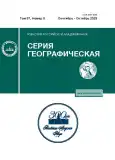Multi-Scale Analysis and Modelling of Spatial Heterogeneity of Income Distribution in Foreign Countries
- Authors: Gladkiy A.S.1
-
Affiliations:
- Lomonosov Moscow State University, Faculty of Geography
- Issue: Vol 87, No 5 (2023)
- Pages: 701-712
- Section: ТЕРРИТОРИАЛЬНАЯ ОРГАНИЗАЦИЯ ОБЩЕСТВА
- URL: https://journals.eco-vector.com/2587-5566/article/view/660767
- DOI: https://doi.org/10.31857/S2587556623050047
- EDN: https://elibrary.ru/EWEEAP
- ID: 660767
Cite item
Abstract
The article deals with the level of socioeconomic development and regional inequality within the territories of countries around the world. The evaluation of the socioeconomic development of countries is proposed by calculating the indicator of gross regional product per unit area. Calculation and mapping of socioeconomic features are provided by the indicator of GRP per sq. km. The analysis of relative GRP per sq. km indicates that the countries of the world can be classified as developed and developing not only by the level of socioeconomic development, but also by the nature of regional inequality. It has been established that the relative GRP distribution is more gradual in developed countries, while developing countries tend to have a high concentration of economic resources in capitals. The calculation of the geographical generalization ratio indicates that for many developed countries (the USA, European countries) the greatest increase in information on the heterogeneity of space occurs at the upper scale level, while for most of the studied developing countries (China, Mexico, Brazil, Argentina) the largest increase is at the lower scale levels. Calculation of the spatial autocorrelation model made it possible to establish the differences between developed and developing countries in terms of the nature of spatial inequality: based on the difference between real and modelled values of spatial autocorrelation. The proposed method of spatial analysis of the distribution of indicators of economic well-being using the methods of spatial statistics can act as an alternative to the criteria traditionally accepted in the economy for determining the developed and developing countries of the world.
About the authors
A. S. Gladkiy
Lomonosov Moscow State University, Faculty of Geography
Author for correspondence.
Email: antony.gladky@gmail.com
Russia, Moscow
References
- Антонов Е.В. Территориальная концентрация экономики и населения в странах Европейского союза и в России и роль глобальных городов // Региональные исследования. 2019. № 3 (65). С. 26–41.
- Баранский Н.Н. Научные принципы географии. М.: Мысль, 1980. 239 с.
- Василевский Л.И., Полян П.М. Системно-структурный подход и экономическая география // Системные исследования: Ежегодник. М.: Издательство “Наука”, 1978. С. 242–260.
- Голубченко И.В. Полимасштабная модель изучения территории: подходы к созданию. Уфа: БГПУ им. М. Акмуллы, 2016. 11 с.
- Григорьев Л.М., Салмина А.А. Структура социального неравенства современного мира: проблемы измерения // Социологический журн. 2013. № 3. С. 5–21.
- Полян П.М., Трейвиш А.И. Территориальные структуры в науке и практике. М.: Знание, 1988. 46 с.
- Самсонов Т.Е. Визуализация и анализ географических данных на языке R. М.: Географический факультет МГУ, 2021. https://tsamsonov.github.io/r-geo-course (дата обращения 01.07.2021).
- Самсонов Т.Е., Юрова Н.Д. Применение картограмм и картодиаграмм на мультимасштабных социально-экономических картах // Геодезия и картография. 2014. № 11. С. 30–38.
- Типология зарубежных стран: учебно-методическое пособие / под ред. А.С. Наумова. М.: Типография “Пеликан”, 2019. 336 с.
- Трейвиш А.И. Географическая полимасштабность в развитии России // География. 2006. № 11. С. 3–8.
- Трейвиш А.И. Принцип полимасштабности в географии и страноведении // Вопросы экономической и политической географии зарубежных стран. Смоленск: Ойкумена, 2007. Т. 17. С. 50–65.
- Трейвиш А.И. География и развитие // География мирового развития. М.: ИГ РАН, 2009. Т. 1. С. 8–43.
- Шевчук Е.И., Кириллов П.Л., Петросян А.Н. Проблема генерализации данных в исследованиях пространственной неоднородности социально-экономических явлений на разных масштабных уровнях // Региональные исследования. 2019. № 3 (65). С. 4–15.
- Almeida E. Econometria espacial aplicada. Campinas: Editora Alínea, 2012. 498 p.
- Grekousis G. Spatial Autocorrelation // Spatial Analysis Methods and Practice: Describe – Explore – Explain through GIS. Cambridge: Cambridge Univ. Press, 2020. P. 207–274.
- Krugman P.R., Venables A.J. Globalization and the Inequality of Nations // The Quarterly J. of Economics. 1995. Vol. 110. № 4. P. 857–880.
- Kuznets S. Economic growth and income inequality // American Economic Review. 1953. Vol. 45. № 1. P. 1–28.
- Milanovic B. Worlds Apart. Measuring International and Global Inequality. Princeton: Princeton Univ. Press, 2005. 240 p.
- Piketty T. Capital in the Twenty-First Century. Cambridge: Harvard Univ. Press, 2014. 686 p.
- Reddit: Map of world GDP density. https://www.reddit.com/r/russia/comments/4ze0ou/map_of_world_gdp_density/ (дата обращения 01.09.2021).
- Shorrocks A. Inequality decomposition by factor components // Econométrica. 1982. Vol. 50. № 1. P. 193–211.
Supplementary files














